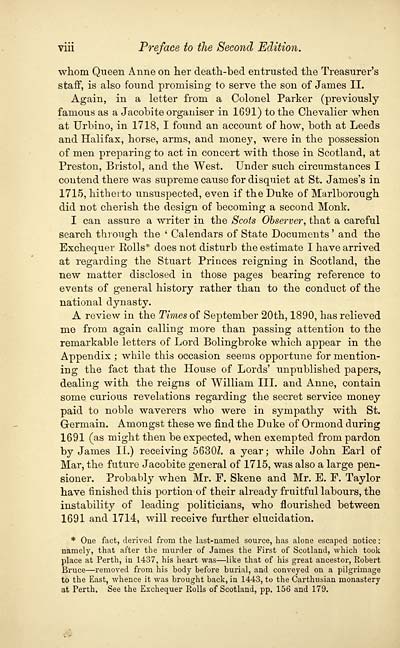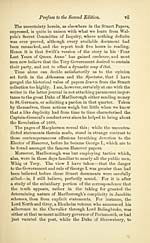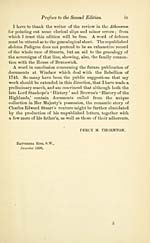Stuart dynasty
(14) Page viii
Download files
Complete book:
Individual page:
Thumbnail gallery: Grid view | List view

viii Preface to the Second Edition.
whom Queen Anne on her death-bed entrusted the Treasurer's
staff, is also found promising to serve the son of James II.
Again, in a letter from a Colonel Parker (previously
famous as a Jacobite organiser in 1691) to the Chevalier when
at Urbino, in 1718, I found an account of how, both at Leeds
and Halifax, horse, arms, and money, were in the possession
of men preparing to act in concert with those in Scotland, at
Preston, Bristol, and the West. Under such circumstances I
contend there was supreme cause for disquiet at St. James's in
1715, hitherto unsuspected, even if the Duke of Marlborough
did not cherish the design of becoming a second Monk.
I can assure a writer in the Scots Observer, that a careful
search through the ' Calendars of State Documents ' and the
Exchequer Polls* does not disturb the estimate I have arrived
at regarding the Stuart Princes reigning in Scotland, the
new matter disclosed in those pages bearing reference to
events of general history rather than to the conduct of the
national dynasty.
A review in the Times of September 20th, 1890, has relieved
me from again calling more than passing attention to the
remarkable letters of Lord Bolingbroke which appear in the
Appendix ; while this occasion seems opportune for mention-
ing the fact that the House of Lords' unpublished papers,
dealing with the reigns of William III. and Anne, contain
some curious revelations regarding the secret service money
paid to noble waverers who were in sympathy with St.
Germain. Amongst these we find the Duke of Orrnond during
1691 (as might then be expected, when exempted from pardon
by James II.) receiving 5630Z. a year; while John Earl of
Mar, the future Jacobite general of 1715, was also a large pen-
sioner. Probably when Mr. F. Skene and Mr. E. F. Taylor
have finished this portion of their already fruitful labours, the
instability of leading politicians, who flourished between
1691 and 1714, will receive further elucidation.
* One fact, derived from the last-named source, has alone escaped notice :
namely, that after the murder of James the First of Scotland, which took
place at Perth, in 1437, his heart was — like that of his great ancestor, Robert
Bruce — removed from his body before burial, and conveyed on a pilgrimage
to the East, whence it was brought back, in 1443, to the Carthusian monastery
at Perth. See the Exchequer Rolls of Scotland, pp. 156 and 179.
whom Queen Anne on her death-bed entrusted the Treasurer's
staff, is also found promising to serve the son of James II.
Again, in a letter from a Colonel Parker (previously
famous as a Jacobite organiser in 1691) to the Chevalier when
at Urbino, in 1718, I found an account of how, both at Leeds
and Halifax, horse, arms, and money, were in the possession
of men preparing to act in concert with those in Scotland, at
Preston, Bristol, and the West. Under such circumstances I
contend there was supreme cause for disquiet at St. James's in
1715, hitherto unsuspected, even if the Duke of Marlborough
did not cherish the design of becoming a second Monk.
I can assure a writer in the Scots Observer, that a careful
search through the ' Calendars of State Documents ' and the
Exchequer Polls* does not disturb the estimate I have arrived
at regarding the Stuart Princes reigning in Scotland, the
new matter disclosed in those pages bearing reference to
events of general history rather than to the conduct of the
national dynasty.
A review in the Times of September 20th, 1890, has relieved
me from again calling more than passing attention to the
remarkable letters of Lord Bolingbroke which appear in the
Appendix ; while this occasion seems opportune for mention-
ing the fact that the House of Lords' unpublished papers,
dealing with the reigns of William III. and Anne, contain
some curious revelations regarding the secret service money
paid to noble waverers who were in sympathy with St.
Germain. Amongst these we find the Duke of Orrnond during
1691 (as might then be expected, when exempted from pardon
by James II.) receiving 5630Z. a year; while John Earl of
Mar, the future Jacobite general of 1715, was also a large pen-
sioner. Probably when Mr. F. Skene and Mr. E. F. Taylor
have finished this portion of their already fruitful labours, the
instability of leading politicians, who flourished between
1691 and 1714, will receive further elucidation.
* One fact, derived from the last-named source, has alone escaped notice :
namely, that after the murder of James the First of Scotland, which took
place at Perth, in 1437, his heart was — like that of his great ancestor, Robert
Bruce — removed from his body before burial, and conveyed on a pilgrimage
to the East, whence it was brought back, in 1443, to the Carthusian monastery
at Perth. See the Exchequer Rolls of Scotland, pp. 156 and 179.
Set display mode to:
![]() Universal Viewer |
Universal Viewer | ![]() Mirador |
Large image | Transcription
Mirador |
Large image | Transcription
Images and transcriptions on this page, including medium image downloads, may be used under the Creative Commons Attribution 4.0 International Licence unless otherwise stated. ![]()
| Histories of Scottish families > Stuart dynasty > (14) Page viii |
|---|
| Permanent URL | https://digital.nls.uk/94817934 |
|---|
| Description | A selection of almost 400 printed items relating to the history of Scottish families, mostly dating from the 19th and early 20th centuries. Includes memoirs, genealogies and clan histories, with a few produced by emigrant families. The earliest family history goes back to AD 916. |
|---|

